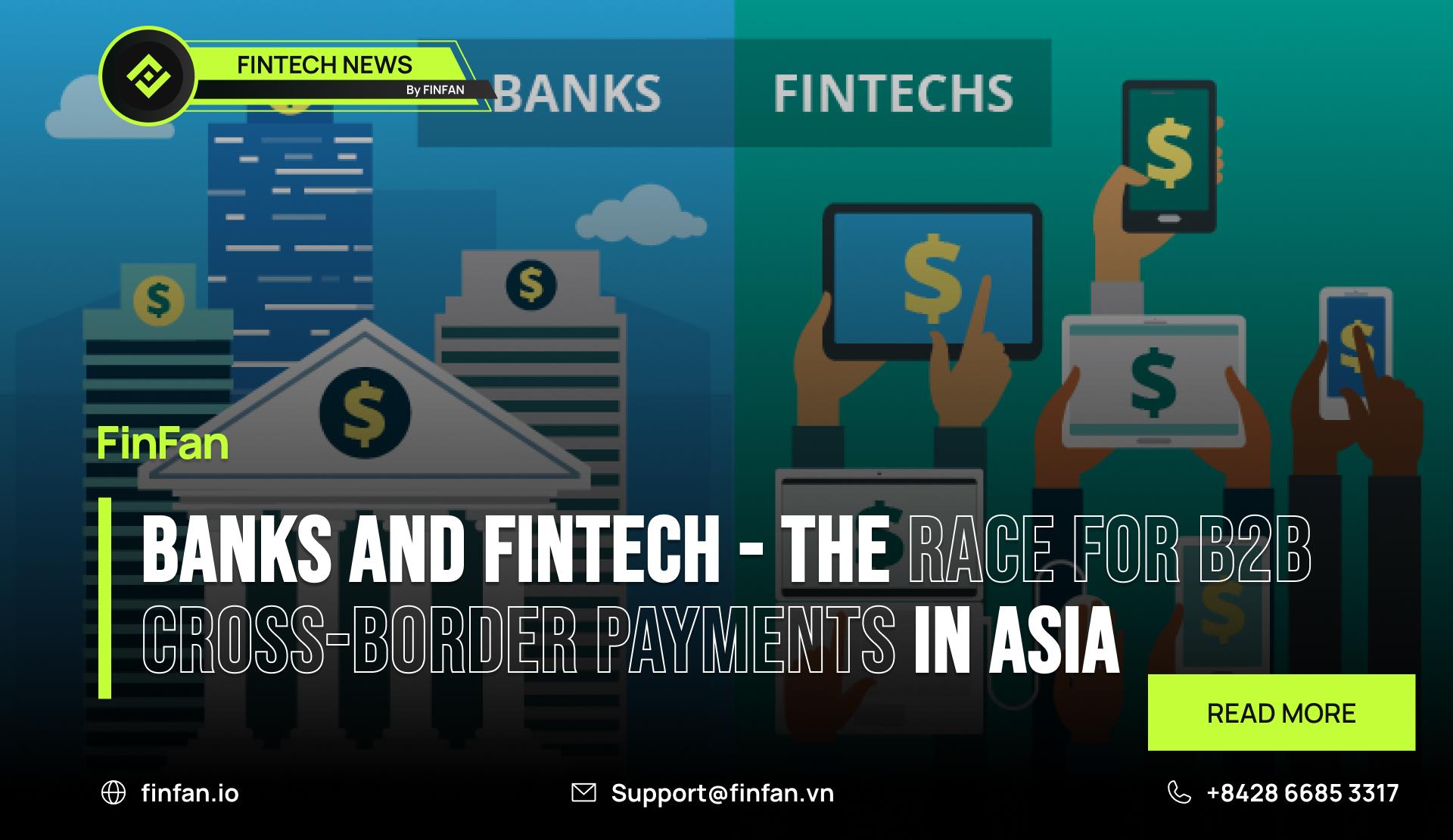B2B cross-border payment Part 7 - Banks and Fintech - The Race for B2B Cross-Border Payments in Asia

In recent years, Asia has emerged as a global hub for economic activity and innovation, driven by rapid digital transformation and growing interconnectedness.
At the forefront of this evolution is the competitive landscape of B2B cross-border payments, where traditional banks and fintech companies are racing to provide “Faster, Safer, and More cost-effective” solutions for businesses.
Banks and Fintech Companies in the B2C Cross-border Payment Sector.
At first, let us, at FinFan, provide an overview of the race between banks and fintech companies in the B2C cross-border payment sector.
The Traditional Banking Model
For decades, traditional banks have dominated the cross-border payment landscape. They have relied on established infrastructures and a network of correspondent banks to facilitate international transactions.
However, this model often involves high fees, long processing times, and a lack of transparency, making it less appealing to consumers seeking quick and affordable solutions.
Despite these challenges, banks continue to hold a significant advantage in terms of trust and regulatory compliance.
Many consumers still view banks as safe and reliable options for managing their finances, particularly when it comes to international transactions.
To maintain their competitive edge, banks are now investing in digital solutions and streamlining their processes to better meet consumer needs.
The Rise of Fintech in Asia
In contrast to the traditional banking model, fintech companies are revolutionizing B2C cross-border payments by offering faster, cheaper, and more transparent services.
Asia's vibrant fintech ecosystem has given rise to numerous startups and established players that are leveraging cutting-edge technologies to enhance the payment experience.
Mobile payment platforms and digital wallets, such as Alipay and WeChat Pay in China, Paytm in India, and GrabPay in Southeast Asia, have gained widespread adoption by offering seamless cross-border transactions.
These platforms use advanced technologies like blockchain, artificial intelligence, and real-time data processing to reduce costs and improve efficiency.
Example 1: The Competition between Traditional Banks and Fintech Companies in the B2C Cross-border Payment Sector in Vietnam.
Some popular banks are trying to transform their core operation into digital banks in Vietnam due to the changing behaviors of young generation customers.
However, the transformation speed of traditional banks is akin to that of a massive aircraft carrier navigating the vast blue oceans; when they wish to change direction, the entire vessel takes a considerable amount of time to do so.
This allows fintech companies, despite being newer entrants, to quickly grasp consumer trends among the younger generation and the cashless payment movement, developing at a rapid pace like a speedboat across the ocean.
Although they are fast, they are not necessarily stable and always require substantial support.
Therefore, the combination of traditional banks and fintech companies has become extremely popular and contributes to providing experiences that are “Faster - Safer - More Cost-Efficient”.
An example of this is the three-way collaboration between international cross-border payment partners like Remitly, Sendwave, Ria Money Transfer, MoneyGram, Paysend, etc. to Vietnam, FinFan, and domestic banks or e-wallet partners offering remittance services to Vietnam through three main methods of receiving funds:
. cash pickup at bank branches,
. real-time transfer directly to the recipient's bank account in Vietnam,
. and real-time transfer to the recipient's e-wallet account in Vietnam.
Example 2: The Competition between Traditional Banks and Fintech Companies in the B2C Cross-border Payment Sector in China.
Contrasing with Vietnam, the fintech companies in China have been investing by big funds around the world, so they have been growing so fast.
It forces the Chinese government to implement measures to counteract market monopolies, as the majority of the payment market, both domestically and internationally, is dominated by major players such as Alipay and WeChat Pay.
Read more:
. Contrasting Situations in the Competition between E-Wallets and Banks in Vietnam and China
The Same Story of Landscape of B2B Cross-Border Payments
Traditionally, cross-border payments in the B2B sector have been dominated by banks. These institutions have leveraged their established networks and infrastructure to facilitate international transactions.
However, the conventional banking process for cross-border payments often involves complex procedures, high fees, and extended processing times. This inefficiency has created a ripe opportunity for fintech companies to disrupt the market.
Fintech firms have introduced innovative technologies that streamline the cross-border payment process, offering businesses quicker transactions, lower fees, and greater transparency.
Their use of blockchain technology, artificial intelligence, and real-time payment systems allows fintech companies to address the pain points that businesses face when dealing with traditional banks.
The Rise of Fintech in Asia
Asia's vibrant fintech ecosystem has played a pivotal role in reshaping the B2B cross-border payments landscape. Countries like China, India, and Singapore have become fintech powerhouses, fostering a dynamic environment for startups and established players alike.
These companies are leveraging cutting-edge technologies to create seamless cross-border payment experiences.
For instance, China's Ant Group and Tencent have expanded their digital payment services to facilitate international transactions.
In India, companies like Paytm and Razorpay are making significant strides in providing cross-border payment solutions tailored to the needs of businesses.
Meanwhile, Singapore's strategic position as a financial hub has attracted numerous fintech companies looking to tap into the Asian market.
Banks Fighting Back
While fintech companies have gained ground, banks are not standing idly by. Recognizing the threat posed by fintech, banks are investing in technology and forging partnerships with fintech firms to enhance their cross-border payment capabilities.
Many banks are adopting digital platforms that offer real-time payments, reducing the reliance on traditional systems like SWIFT.
Collaborations between banks and fintech companies are becoming more common, allowing banks to leverage fintech innovation while providing the regulatory compliance and trust that many businesses still seek.
These partnerships aim to create a win-win situation where banks can offer enhanced services while fintech companies can access a broader customer base.
The Regulatory Landscape
The race for dominance in B2B cross-border payments in Asia is also shaped by the regulatory environment.
Regulators across the region are working to create frameworks that foster innovation while ensuring the security and stability of financial systems.
The push for open banking and standardized APIs is driving collaboration between banks and fintech companies, encouraging the development of interoperable solutions.
However, navigating the regulatory landscape remains a challenge for both banks and fintech firms.
Differences in regulations across countries can complicate cross-border transactions, making it essential for companies to stay informed and adaptable to changes in the regulatory environment.
The Future of B2B Cross-Border Payments
As banks and fintech companies continue to compete and collaborate, the future of B2B cross-border payments in Asia looks promising.
The integration of technologies such as blockchain, artificial intelligence, and machine learning is expected to further streamline processes and enhance security.
Businesses will benefit from increased competition, as banks and fintech companies strive to offer more efficient and cost-effective solutions. This competition will likely drive down costs and reduce transaction times, ultimately boosting economic activity and cross-border trade in the region.
Conclusion Regarding The Race for B2B Cross-Border Payments in Asia
In conclusion, the race for B2B cross-border payments in Asia is intensifying as banks and fintech companies vie for dominance.
The convergence of technology and finance is transforming the landscape, creating new opportunities for businesses and reshaping the way cross-border transactions are conducted.
As this race continues, businesses can look forward to a more connected and seamless global economy.
At FinFan, we are excited to be part of this transformative journey, working alongside banks and fintech companies to provide innovative cross-border payment solutions that meet the evolving needs of businesses in Vietnam, Asia, and beyond.
This article was curated and authored by FinFan's market research and development team, alongside our marketing department.
About FinFan
FinFan is a cross-border embedded financial services company that focuses on mass disbursement, fund collection, card processing, IBAN, and digital APMs solutions, which can provide valuable input and integration on and for the same.
FinFan is already integrated with almost the world's well-known MTOs, PSPs, switch, and core fintech platforms such as Money Gram, Thunes, Qiwi, Remitly, World Remit, Bancore, PaySend, Terrapay, Ria Money Transfer (Euronet), Dlocal, Ripple, TripleA, FoMo Pay, Wings, etc.
For more information, please get in touch with us through:
🌐https://finfan.io
📞(+84) 2866 85 3317
✉ support@finfan.vn
LinkedIn: FinFan





